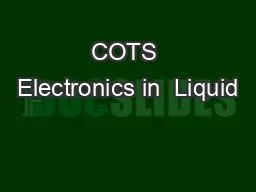

Nitrogen 4262018 TEMPETM 110 2 Tetiana Pridii TEMPEEP Outline Motivation Testing Microcontroller cryo board Components testing campaign Design of FPGA cryo board Conclusions ID: 783991
Download The PPT/PDF document "COTS Electronics in Liquid" is the property of its rightful owner. Permission is granted to download and print the materials on this web site for personal, non-commercial use only, and to display it on your personal computer provided you do not modify the materials and that you retain all copyright notices contained in the materials. By downloading content from our website, you accept the terms of this agreement.
Slide1
Slide2COTS Electronics in Liquid Nitrogen
4/26/2018
TE-MPE-TM #110
2
Tetiana Pridii,
TE-MPE-EP
Slide3OutlineMotivation
TestingMicrocontroller cryo boardComponents testing campaign
Design of FPGA cryo board
Conclusions
4/26/2018
TE-MPE-TM #110
3
Slide4The idea
Goal :Embedded electronics
working at 77K confined
inside of the superconducting magnet ,
without
wires
towards exterior
Major challenges
:
electronic data acquisition system of high precision at low temperatureelectronics for the wireless communication link at low temperaturewireless powering system
4/26/2018
TE-MPE-TM #110
4
Smart Diagnostics
Slide5In order to do our first tests, we chose to use a robust and widely used 8051-based core microcontroller provided on a single chip data acquisition system from Analog Devices : ADuC831 & ADuC834
Examples of QPS circuit boards using
ADuC family
4/26/2018
TE-MPE-TM #110
5
Board
Description
Qty.
installed
DQQBS
Bus-bar Splice Protection System
2048
DQQDC
Protection System for HTS Current Leads
1192
DQAMx
Crate controller
2524
Slide6Main characteristics
4/26/2018TE-MPE-TM #110
6
ADuC831
ADuC834
12-bit SAR ADC
24-bit
Σ
-
Δ
ADC
Operational clock speed range 400 kHz to 16 MHz
(
internal oscillator or
external clock source)
on-chip PLL that locks onto a multiple of 32.768 kHz generating a high frequency clock of 12.58 MHz
(internal oscillator)
2.5V internal reference
1.25V internal reference
Slide74/26/2018
TE-MPE-TM #110
7
Microcontroller
cryo
board
Cryo
specific
Suitable passive components selected
(NP0 ceramic, Tantalum & film capacitors)
Flexible design
Suitable for ADuC831 & ADuC834
Various optional on-board voltage references
Optional external feeding for clock and voltage reference
Optional input buffers for the ADC
Slide8Testing microcontroller cryo board in liquid nitrogen
All the data acquisition, instruments control and acquired data post-processing was done with MATLAB.
4/26/2018
TE-MPE-TM #110
8
Results
:
Good performance
Small signal distortion due to changes in reference
(input adjusted to reference in LN)
Lower power consumption (~
-34%)
Slide94/26/2018
TE-MPE-TM #110
9
Room Temperature
Liquid Nitrogen
mean = 1.50014
V
sigma = 263.313
uV
mean = 1.4138 V
sigma
= 291.843
uV
Noise Measurements
ADuC831
Room Temperature
Liquid Nitrogen
mean = 1.50713V
sigma = 9.8572
uV
ADuC834
mean = 1.49915 V
sigma
= 4.22359
uV
sigma
: 1.6875
uV
sigma : 0.99372
uV
Shorted differential inputs for ADuC834 :
Input 1.5V
:
Input 1.5V :
Slide10Total Harmonic Distortion
4/26/2018
TE-MPE-TM #110
10
ADuC831
ADuC834
Room Temperature
Liquid Nitrogen
Room Temperature
Liquid Nitrogen
2.25V, 1kHz
1.5V, 300mHz
THD:
-55.41 dB
THD
:
-72.09
dB
THD:
-81.19 dB
THD:
-82.26
dB
Slide11Linearity
ADuC831
ADuC834
Room Temperature
Liquid Nitrogen
Room Temperature
Input: 0V -
2.5 in 26 steps
Max Error = 12mV (0.469%)
Max Error = 1.55
mV
( 0.061%)
Liquid Nitrogen
Internal Reference
Max
Error = 142mV (5.68%)
AD780 Reference
Max
Error =51mV (2.04%)
Max Error =0.5mV (0.2%)
Input:
0.05V
-
2.45V
in 49 steps
Slide12Components testing campaign
4/26/2018TE-MPE-TM #110
12
Voltage
Reference
Nominal Value
Value in LN
ADR02
bandgap
5V
4.953V
AD780
bandgap
2.5V
2.485V
LT461
bandgap
2.5V
5V
ADuC831 Internal Reference
bandgap
2.5V
2.659V
MAX6325
buried zener
2.5V
0.354V
ADR421
XFET
2.5V
0.243V
LDO
Room
Temperature
Liquid Nitrogen
Iout,max
Vout
Iin
Vout
Iin
LM1086
3A
1.254V
11mA
0.012V
0.6mA
LT1965
1.1A
1.199V
1mA
1.076V
0.5mA
MCP1827
1.5A
1.209V
0.6mA
1.183V
0.5mA
NCV565
1.5A
1.195V
2.1mA
0.463V
0.5mA
TPS7860
1.5A
1.226V
0.7mA
1.048V
0.7mA
MIC49300
3A
1.209V
21.7mA
2.235V
10.1mA
LDO
Iout,max
Room Temperature
Liquid Nitrogen
TPS7A4533
1.5A
3.291V
3.190V
LMS1587
3A
3.287V
0.172V
Slide134/26/2018
TE-MPE-TM #110
13
Components testing campaign
Room Temperature
Liquid
Nitrogen
DCDC
Typ
Efficiency
Vin, I in
Vout, I out
Vin, I in
Vout
, I out
Cold Efficiency
Murata MEJ2D0515SC
(out current max +-67mA)
76-79%
5V
269.3mA
34mA
5V
39.4mA
+-2.006V
4.27
mA
8.7
%
TRACO TMV 2-0515DHI
(out current max +-35mA)
73%
5V
246.9mA
30mA
5V
27.3mA
+-1.064V
2.26
mA
3.5
%
TRACO TMR 3-0523
(out current max +-65mA)
81%
5V
252.5mA
5V
583.5mA
+-19.29V
61.2mA
80.9
%
Cold Start
5V
169mA
+-11.3V
139mA
RECOM RS-0515D
(out current max +-67mA)
75%
5V
252.8mA
31.8mA
5V
382.2mA
+-15.18V
47mA
74.7
%
Slide14WiFi Modules
4/26/2018
TE-MPE-TM #110
14
Slide15FPGA cryo board
4/26/2018
TE-MPE-TM #110
15
Slide16ConclusionsComponent selection is crucial (big variation in behavior)
A working data acquisition system in cold was demonstratedAn advanced component/system testing board is in preparation
4/26/2018
TE-MPE-TM #110
16
Slide17Thank you for your attention!
4/26/2018
TE-MPE-TM #110
17
Slide18